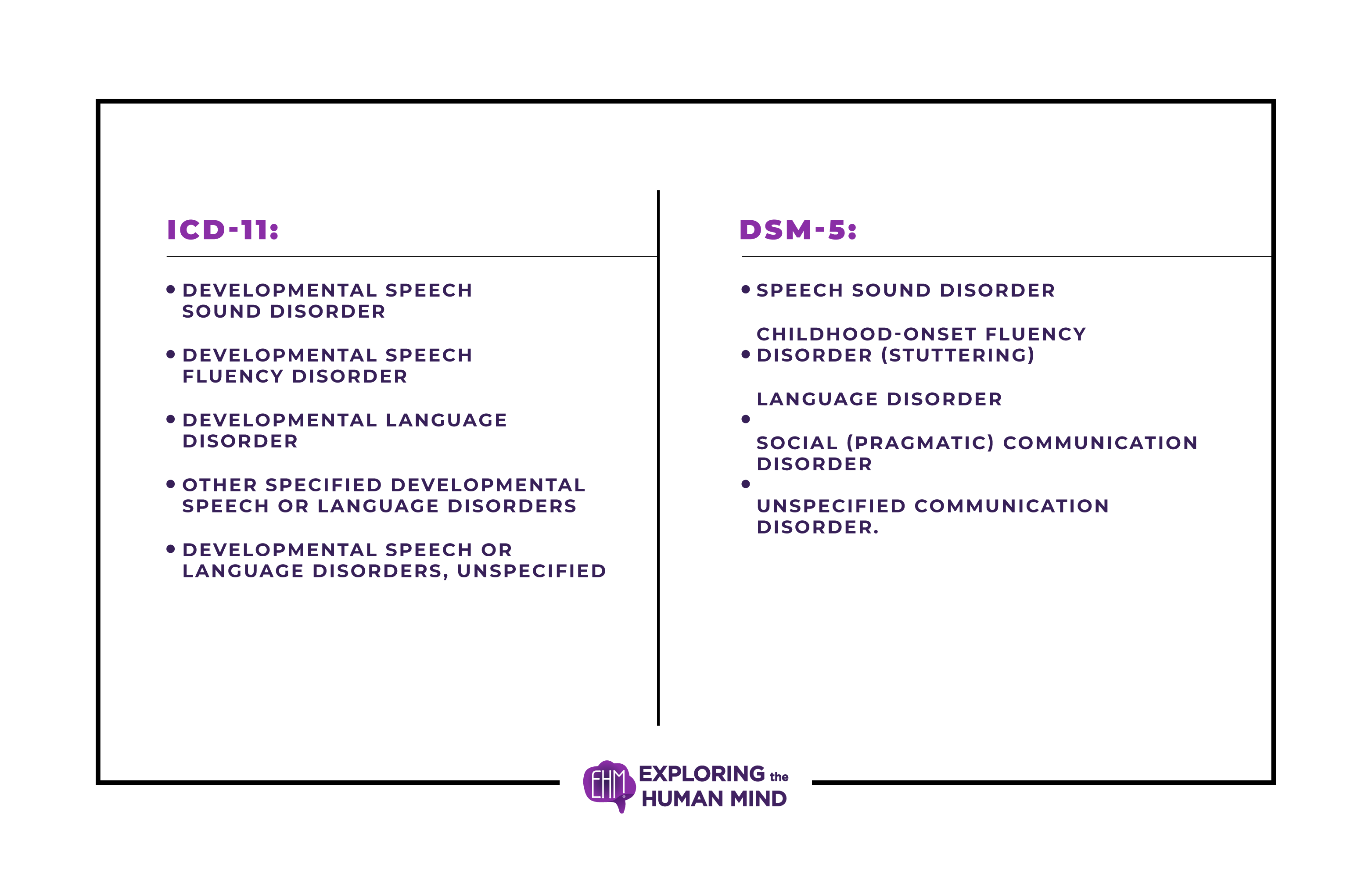Communication Disorder Intro
As we discussed, the 2 systems have very similar categories:

Speech-sound disorder
Developmental speech sound disorder is characterized by difficulties in the acquisition, production, and perception of speech that result in errors of pronunciation, either in the number or types of speech errors made or the overall quality of speech production, that are outside the limits of normal variation expected for age and level of intellectual functioning and result in reduced intelligibility and significantly affect communication.
“"Persistent trouble with speech sound production that interferes with speech intelligibility or hinders verbal transmission of messages," according to the major diagnostic criteria for speech sound disorder.”
[Childhood-Onset] Speech Fluency Disorder (Stuttering)
Developmental speech fluency disorder is characterized by frequent or extensive disturbance of the usual rhythmic flow and tempo of speech, as well as blocking and word avoidance or substitutes. The verbal dysfluency persists over time. The start of speech dysfluency begins throughout the formative period, and speech fluency is significantly lower than would be predicted for age.
The diagnostic criteria for childhood-onset fluency disorder (stuttering) are “disturbances in the normal fluency and time patterning of speech …” and the disturbance causes “anxiety about speaking ….”
Language Dissorder
Developmental language disorder is defined as persistent deficits in the acquisition, comprehension, production, or use of language (spoken or signed) that occur during the developmental period, typically during early childhood, and cause significant limitations in the individual's ability to communicate.
“Language disorders are defined by "persistent difficulties in the acquisition and use of language across modalities (i.e., spoken, written, sign language, or other) due to deficits in comprehension or production," as well as language abilities that are "substantially and quantifiably" below age expectations.”
Social (pragmatic) communication disorder
The criteria for social (pragmatic) communication disorder, a new DSM diagnosis, are "persistent difficulties in the social use of verbal and nonverbal communication," which include deficits in "using communication for social purposes...," "impairment in the ability to change communication to match context or the needs of the listener...," "difficulties following rules for conversation and storytelling...," and "difficulties understanding what is not explici This communication issue is not identified in children who fit the criteria for autism spectrum disorder.
Unspecified communication disorder
Unspecified communication disorder refers to children who display some of the characteristics associated with other CDs. Children with nonspecific communication problem, on the other hand, do not fulfill the exact diagnostic criteria for any of the other communication disorders.
Reference:
https://www.mastersincommunications.org/everything-about-communication-disorders/
International Classification of Diseases for Mortality and Morbidity Statistics, 11th Revision, v2022-02.https://www.findacode.com/icd-11/code-33269655.html
Diane Paul, PhD, CCC-SLP, CAE. DSM-5 Diagnostic Criteria for Communication and Other Neurodevelopmental Disorders. https://higherlogicdownload.s3.amazonaws.com/SPED/e9a4552e-ad48-4c26-9f6c-7fa9cd50d362/UploadedImages/DSM-5%20for%20DCDD_ed.pdf
Tiara Blain, Types of Communication Disorders. September 12, 2022 https://www.verywellmind.com/communication-disorder-types-5220602#toc-types-of-communication-disorders



Comments
Post a Comment